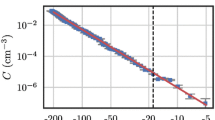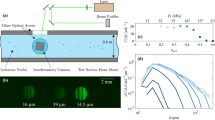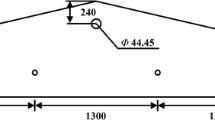Abstract
Nuclei, or microbubble, populations control the inception and dynamics of cavitation. It is, therefore, important to quantify distributions in cavitation test facilities to rigorously model nucleation dynamics. Measurements of natural nuclei population dynamics were made in two test facilities in Australia and Japan via mechanical activation using a Cavitation Susceptibility Meter (CSM). A range of tunnel operating parameters, including pressure, velocity and dissolved oxygen (DO) content, were investigated. The DO saturation condition upstream of the test section is found to provide a threshold as to whether the population is affected by DO in the Australian test facility. Historical trends in the population are quantified, indicating that regular monitoring is required. Variation of the population around the Australian cavitation tunnel circuit was studied by varying the water sampling location. Provided the water remains undersaturated, as defined above, the natural nuclei population in the test section can be measured by sampling from the lower limb resorber. Comparisons are made between test facilities in Australia, Japan and other countries, as well as environmental waters, using different measurement techniques. Optical and acoustic methods show microbubbles in the size range of 10–100 \(\,{\upmu }\hbox {m}\) typical of those used to model cavitation nucleation. CSM measurements show varying distributions of nuclei with equivalent bubble diameters in the range of 0.5–5 \(\,{\upmu }\hbox {m}\) but global trends suggest a universal characteristic.
Graphic abstract
























Similar content being viewed by others
References
Arndt R, Keller A (1976) Free gas content effects on cavitation inception and noise in a free shear flow. In: Two phase flow and cavitation in power generation systems. Grenoble, 30 March–2 April 1976
Atlar M (2002) The specialist committee on water quality and cavitation-final report. In: Proceedings of 23rd ITTC, 2
Billet M (1984) Cavitation nuclei measurements. In: ASME international symposium on cavitation inception, New Orleans, LA
Billet ML (1985) Cavitation nuclei measurements-a review. In: Cavitation and multiphase flow forum
Brandner P (2018) Microbubbles and cavitation: microscales to macroscales. In: 10th international cavitation symposium on (CAV2018)
Brandner P, Lecoffre Y, Walker G (2007) Design considerations in the development of a modern cavitation tunnel. In: 16th Australasian fluid mechanics conference
Brandner PA, Venning JA, Pearce BW (2018) Wavelet analysis techniques in cavitating flows. Philos Trans R Soc A Math Phys Eng Sci 376(2126):20170242
Breitz N, Medwin H (1989) Instrumentation for insitu acoustical measurements of bubble spectra under breaking waves. J Acoust Soc Am 86(2):739–743
Brennen CE (1994) Observations of cavitating flow. In: Proceedings of 20th symposium on naval hydrodynamics, National Academy Press
Brennen CE (1995) Cavitation and bubble dynamics. Cambridge University Press, Cambridge
Chang N, Yakushiji R, Ganesh H, Ceccio S (2009) Mechanism and scalability of tip vortex cavitation suppression by water and polymer injection. In: Proceedings of 7th international symposium on cavitation
d’Agostino L, Acosta A (1991) Separation and surface nuclei effects in a cavitation susceptibility meter. J Fluids Eng 113(4):695–698
Deane GB, Stokes MD (2002) Scale dependence of bubble creation mechanisms in breaking waves. Nature 418(6900):839
Fox FE, Herzfeld KF (1954) Gas bubbles with organic skin as cavitation nuclei. J Acoust Soc Am 26(6):984–989
Franc JP, Michel JM (2006) Fundamentals of Cavitation, vol 76. Springer, New York
Franklin R (1992) A note on the radius distribution function for microbubbles of gas in water. ASME Cavitat Multiphase Flow Forum 135:77–85
Franklin R (1994) The cavitating submerged jet. American Society of Mechanical Engineers, New York (Tech. rep.)
Garrett C, Li M, Farmer D (2000) The connection between bubble size spectra and energy dissipation rates in the upper ocean. J Phys Oceanogr 30(9):2163–2171
Gates E, Billet M, Katz J, Ooi K, Holl J (1979) Cavitation inception and nuclei distributions joint ARL/CIT experiments. Pennsylvania Stat Univ University Park Applied Research Lab, Tech. rep
Gavrilov L (1969) On the size distribution of gas bubbles in water. Sov Phys Acoust 15(1):22–24
Gindroz B (1995a) Propeller cavitation characteristics: The practical interest of nuclei measurements in test facilities and at sea. In: Proceedings of ASME FED symposium on cavitation
Gindroz B, Billard JY, Geistdoerfer P (1995b) Cavitation nuclei measurements at sea. ASME Publications HTD 321:497–504
Gindroz B, Bailo G, Matera F, Elefante M (1997) Influence of the cavitation nuclei on the cavitation bucket when predicting the full-scale behavior of a marine propeller. In: Proceedings of 21st symposium on naval hydrodynamics, pp 839–850
Gowing S, Shen YT (2001) Nuclei effects on tip vortex cavitation scaling. In: 4th international symposium on cavitation, California
Gowing S, Vikram C, Burton S (1988) Comparison of holographic, light scattering and venturi techniques for bubble measurements in a water tunnel. In: ASME cavitation and multiphase flow forum, pp 25–28
Harvey EN, Barnes D, McElroy WD, Whiteley A, Pease D, Cooper K (1944) Bubble formation in animals. I. Physical factors. J Cell Physiol 24(1):1–22
Johnson BD, Cooke RC (1981) Generation of stabilized microbubbles in seawater. Science 213(4504):209–211
Katz J (1982) Cavitation inception in separated flows. PhD thesis, California Institute of Technology
Keller A, Weitendorf E (1976) Influence of undissolved air content on cavitation phenomena at the propeller blades and on induced hull pressure amplitudes. In: Proceedings lAHR symposium on two phase flow and cavitation in power generation system, pp 65–76
Khoo M, Venning J, Pearce B, Brandner P, Lecoffre Y (2016) Development of a cavitation susceptibility meter for nuclei size distribution measurements. In: 20th Australasian fluid mechanics conference
Khoo M, Venning J, Takahashi K, Arai J, Mori T, Pearce B, Brandner P, Ranmuthugala D (2017) Joint research between Australia and Japan on the cavitation inception of marine propellers and control surfaces. MAST Asia 2017:1–6
Kwak HY, Oh SD (2004) Gas-vapor bubble nucleation—a unified approach. J Colloid Interface Sci 278(2):436–446
Liu Z, Sato K, Brennen CE (1993) Cavitation nuclei population dynamics in a water tunnel. ASME Am Soc Mech Eng 153:119–124
Mori T, Naganuma K, Kimoto R, Yakushiji R, Nagaya S (2007) Hydrodynamic and hydroacoustic characteristics of the Flow Noise Simulator. In: Proceedings of 5th ASME-JSME joint fluids engineering conference, FEDSM2007-37531
Nagaya S, Kimoto R, Naganuma K, Mori T (2011) Observation and scaling of tip vortex cavitation on elliptical hydrofoils. In: ASME-JSME-KSME 2011 joint fluids engineering conference, American Society of Mechanical Engineers, pp 225–230
Němec T (2016) Homogeneous bubble nucleation in binary systems of liquid solvent and dissolved gas. J Chem Phys 467:26–37
Norris SJ, Brooks I, de Leeuw G, Sirevaag A, Leck C, Brooks B, Birch C, Tjernstrom M (2011) Measurements of bubble size spectra within leads in the arctic summer pack ice. Ocean Sci
Pascal RW, Yelland MJ, Srokosz MA, Moat BI, Waugh EM, Comben DH, Cansdale AG, Hartman MC, Coles DG, Chang Hsueh P (2011) A spar buoy for high-frequency wave measurements and detection of wave breaking in the open ocean. J Atmos Ocean Technol 28(4):590–605
Peterson F, Danel F, Keller A, Lecoffre Y (1975) Comparative measurements of bubble and particulate spectra by three optical methods. Report of Cavitation Committee, 14th ITTC
Pham T, Michel J, Lecoffre Y (1997) Dynamical nuclei measurement: on the development and the performance evaluation of an optimized center-body meter. J Fluids Eng 119(4):744–751
Randolph K, Dierssen HM, Twardowski M, Cifuentes-Lorenzen A, Zappa CJ (2014) Optical measurements of small deeply penetrating bubble populations generated by breaking waves in the Southern Ocean. J Geophys Res Oceans 119(2):757–776
Russell P, Giosio D, Venning J, Pearce B, Brandner P, Ceccio S (2018) Microbubble disperse flow about a lifting surface. In: 32nd symposium on naval hydrodynamics, Hamburg
Russell P, Venning J, Pearce B, Brandner P (2019) Calibration of Mie Scattering Imaging for microbubble measurement in hydrodynamic test facilities. Manuscript submitted for publication
Shen Y, Gowing S, Pierce R (1984) Cavitation susceptibility measurements by a venturi. In: ASME international symposium on cavitation inception, New Orleans, LA
Shen YT, Gowing S, Eckstein B (1986) Cavitation susceptibility measurements of ocean lake and laboratory waters. Tech. rep, David W Taylor Naval Ship Research and Development Center, Bethesda, MD
Stramski D, Boss E, Bogucki D, Voss KJ (2004) The role of seawater constituents in light backscattering in the ocean. Prog Oceanogr 61(1):27–56
Takahashi K, Arai J, Mori T (2019) Nuclei population dynamics in NSRC/ATLA Flow Noise Simulator. Technical report, Acquisition, Technology & Logistics Agency, Japan
Venning J, Khoo M, Pearce B, Brandner P (2018) Background nuclei measurements and implications for cavitation inception in hydrodynamic test facilities. Exp Fluids 59(4):71
Ward C, Balakrishnan A, Hooper F (1970) On the thermodynamics of nucleation in weak gas–liquid solutions. J Basic Eng 92(4):695–701
Warneck P, Williams J (2012) The atmospheric chemist’s companion: numerical data for use in the atmospheric sciences. Springer, New York
Worch E (2015) Hydrochemistry: basic concepts and exercises. Walter de Gruyter GmbH & Co KG
Zhang X (2001) Influence of bubbles on the water-leaving reflectance. PhD thesis, Dalhousie University
Acknowledgements
The authors acknowledge the support of the University of Tasmania, the Defence Science and Technology Group and the Acquisition, Technology & Logistics Agency. The authors thank AMC technical officers, Mr. Robert Wrigley and Mr. Steven Kent, and ATLA technical officer, Mr. Kenji Naganuma, for providing technical assistance with test facility configuration and operation as well as CSM hardware configuration.
Author information
Authors and Affiliations
Corresponding author
Additional information
Publisher's Note
Springer Nature remains neutral with regard to jurisdictional claims in published maps and institutional affiliations.
Electronic supplementary material
Below is the link to the electronic supplementary material.
Rights and permissions
About this article
Cite this article
Khoo, M.T., Venning, J.A., Pearce, B.W. et al. Natural nuclei population dynamics in cavitation tunnels. Exp Fluids 61, 34 (2020). https://doi.org/10.1007/s00348-019-2843-x
Received:
Revised:
Accepted:
Published:
DOI: https://doi.org/10.1007/s00348-019-2843-x




